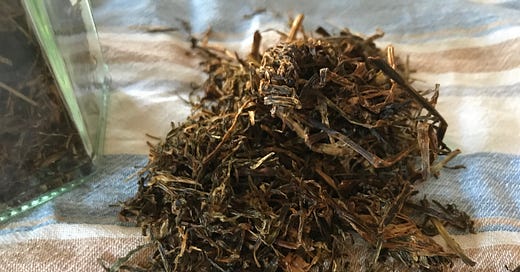As I’ve written about elsewhere, buying an ingredient before I quite know what I am going to do with it has been an occasional way of spurring myself on and out of my cooking comfort zone.
In this case, though, I believe the bag of jimbu came about because I wanted to buy something from my friend’s friend’s who was selling items from her village one Saturday at the farmer’s market, and that was what caught my attention.
Transferring the wiggly strands of jimbu from bag to jars revealed a lot of more of the herb than I’d expected. It was generously packed in, and resembled dried, crumpled grass, only vaguely stickier.
Not gonna lie, this was a while ago now and it’s only been in recent months that I’ve begun using it. And it’s made my Nepali cooking taste more authentic than anything else I’ve done.
I like this description of jimbu taken from The Nepal Cookbook, put out by the Association of Nepalis in the Americas:
Jimbu
Dried, aromatic grass from the Himalayan regions. It is sold in strands, and just a small pinch is enough to flavor a dish … As a substitute, people sometimes use the roots of bulb garlic, but this does not duplicate the distinctive flavor of jimbu.
The herb is painstakingly gathered by hand in the mountainous regions of Mustang, where it’s used much more than it is here. It reaches us in Kathmandu in its dried form, but I wonder if there it’s used fresh, and how that would taste. Jimbu gives a distinctive flavor to the food served at the many Thakali restaurants that have become so popular in the city over the last few years, particularly as an addition the creamy, delicious black dal they serve. It seems to be only found in Nepal and a few parts of India, and, at least here, is mostly wild-gathered, though it seems it can be cultivated.
Writing about jimbu is leading me to more questions about it, and to me that’s a good thing; I will start asking people. The fact that after so many years here there’s still new and interesting things for me to learn about—that really brings me joy.
**
At home, I usually use Masoor dal, the small split orange lentils. It cooks fast, and I enjoy the taste. Sometimes I’ve cooked it as a sort of lentil soup with added vegetables, but most often I make it in the Nepali style (or my attempt at such). It never really had that elusive something, though, until I started adding jimbu.
Once I did, I may have gotten a little carried away, tossing in even more when I reheated my dal on successive days. It’s hard to describe the taste of jimbu. While it is part of the onion family, it doesn’t really taste like any of the big hitters, onions and garlic, or even chives. But yet it is familiarly similar to them, while still having something uniquely its own. It smells of allium as a whole rather than any individual one, deeply concentrated and old.
I’m making myself hungry for a pot of good orange dal just typing this, and fortunately all the ingredients are just a room away…
**
If you’re reading this from Nepal, I’d love to hear how you use jimbu: at this rate it’ll take me a long time to use up my stock, so I need more ideas! And if you’re somewhere else, you can enjoy a delicious pot of dal without it, of course—but if you ever do come across jimbu in a specialty shop or being used in a Nepali restaurant, I’d be curious to know what you think it tastes like.



